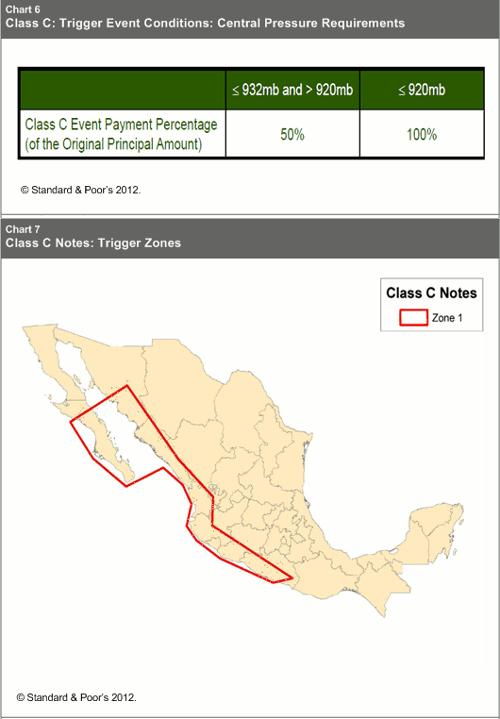The U.S. National Hurricane Center (NHC) has finally delivered its final tropical cyclone report for hurricane Patricia, putting the minimum central pressure of the storm at 932mb at landfall on the Mexican coast, suggesting the MultiCat Mexico Ltd. (Series 2012-1) Class C catastrophe bond notes face at least a 50% loss.
We say suggests, as the final report from calculation agent AIR Worldwide will be required before a determination can be made as to the fate of the notes and the size of any loss to investors.
However the MultiCat Mexico 2012 Class C parametric trigger terms (seen below) specify that a minimum central pressure of between 932mb and 920mb (within the parametric trigger box) would result in a 50% loss of principal to investors, which in the case of this final landfall pressure level from the NHC now seems assured.

MultiCat Mexico Ltd. Series 2012-1 Class C notes hurricane zone and trigger parameters
As you can see above, the MultiCat Class C trigger zone begins just off the Mexican coastline, meaning that there was little time and distance between hurricane Patricia entering the parametric zone for the Class C notes and reaching landfall.
If hurricane Patricia had a minimum central pressure of 932mb to 921mb within the parametric box a 50% loss to the $100m tranche of notes is assured. That seems almost impossible to dispute now that we know that 932mb was the official pressure at landfall, and it can only have been lower when the hurricane actually entered the Class C trigger zone.
However, how quickly could the pressure have risen as the center of Patricia passed into the box and headed for the Mexican coastline to make landfall? Could that have been more than 12%, resulting in a central pressure of 920mb or below when the hurricane entered the MultiCat parametric trigger area? If so, that would mean a 100% loss of principal.
It will come down to AIR Worldwide’s interpolation of the track of hurricane Patricia and how the pressure rose as the storm approached landfall, meaning that investors may have a few more days to wait to understand the fate of their investments.
Interestingly, the NHC has again referenced pressure recordings made by storm chasers within its report. As we wrote previously these recordings were again significantly higher than the NHC’s own observations from the storm. How much bearing these readings have had on the final report is impossible to tell.
Artemis spoke with Andrew Siffert, Assistant Vice President and Senior Meteorologist at BMS Intermediaries Inc., to get his opinion on the final data release from the NHC.
Siffert explained; “The dramatic increase in pressure at landfall shows that there is still a lot of uncertainty in examining weather data in real-time for landfalling hurricanes. Post storm analysis of additional data determined more weakening than the real – time estimate. In fact I think storm chaser data from Josh Morgerman @icyclone who was located a couple nautical miles inland from the landfall points played a critical role in this determination of a higher pressure at landfall.
“So without and exact reporting station near the landfall location there is still some uncertainly on the exact pressure at landfall on the order of 2-3 mb but clearly no where near the initial landfall pressure of 920mb as indicated by the NHC initial estimates.”
What exactly this all means for future catastrophe bonds and trigger design in general is uncertain, but the changes in pressure from initial in-storm estimates, to the final reports, has again proven to be significant in the triggering of a cat bond.
“This is very interesting because this is the first cat bond to trigger since hurricane Katrina and given the overall lack of population near the landfall location in this case the Cat bond goes above and beyond its financial obligation to aid in repairs from an area that suffered only minor loss from this event,” Siffert commented.
And on whether central pressure remains a useful factor for triggering catastrophe bonds at all, Siffert said; “The cat bond continues to raise the question about the wind pressure relationship for landfalling storms and future cat bonds need to account for this uncertainty.”
Based on this final tropical cyclone report data it looks like a 50% loss is the most likely outcome for the investors in the MultiCat Mexico Ltd. (Series 2012-1) Class C catastrophe bond notes. We’ll update you should any further details become available, or when the final determination has been made and the loss confirmed.
Finally, for those who remember or have been watching secondary cat bond trading, the MultiCat Class C notes had been trading at a price of 20 which suggests that whoever was speculating may indeed have picked up a bargain, if the tranche does only face a 50% loss.
Read all our coverage of the MultiCat Mexico 2012 Class C notes and hurricane Patricia’s potential impact below (most recent first):
– MultiCat cat bond downgraded to default, uncertainty on loss remains.
– Speculative investors buy MultiCat cat bond, in hope not a full loss.
– S&P downgrades MultiCat cat bond notes on default expectation.
– Pressure recordings show uncertainty in MultiCat cat bond loss.
– S&P put MultiCat Mexico Class C notes on negative watch post-Patricia.
– MultiCat Mexico cat bond facing hurricane Patricia loss, but how much?
– Cat bond market pricing MultiCat Class C for potential loss.
– Hurricane Patricia intensifies further, MultiCat cat bond risk rising.
– Hurricane Patricia heads for Mexico, MultiCat cat bond at risk?
 View all of our Artemis Live video interviews and subscribe to our podcast.
View all of our Artemis Live video interviews and subscribe to our podcast.
All of our Artemis Live insurance-linked securities (ILS), catastrophe bonds and reinsurance video content and video interviews can be accessed online.
Our Artemis Live podcast can be subscribed to using the typical podcast services providers, including Apple, Google, Spotify and more.































